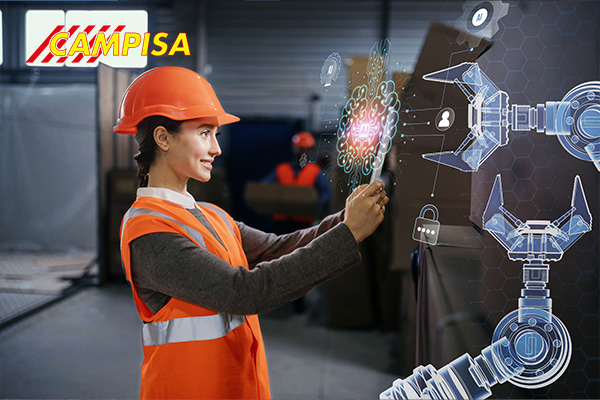Industrial evolution: the new era of industry 5.0

Over the past few decades, we have witnessed an unprecedented technological revolution in the manufacturing industry. This transformation has led to the creation of terms such as “Industry 4.0” and, more recently, “Industry 5.0”. In this article, we will explore the evolution from 4.0 to 5.0 and their key differences.
INDUSTRY 4.0: THE BEGINNING OF THE DIGITAL REVOLUTION
Industry 4.0, also known as the fourth industrial revolution, was born at the beginning of the 21st century. This movement marked the widespread adoption of digital technologies and the interconnection of industrial machines and processes. Key features of Industry 4.0 include:
Internet of Things (IoT): The interconnection of devices, machines and sensors to collect data in real time.
Big Data and Analytics: The use of massive data to optimize processes, improve predictive maintenance and make informed decisions.
3D Printing and Automation: The use of advanced technologies for custom manufacturing and manufacturing.
Artificial Intelligence and Machine Learning: The automation of decision-making processes and the improvement of efficiency.
Cybernetics and Security: The focus on protecting data and industrial systems from cyber threats.
Industry 4.0 has revolutionized manufacturing, improving efficiency, reducing costs and paving the way for greater product customization.
INDUSTRY 5.0: THE HUMANIZATION OF INDUSTRY
While Industry 4.0 has brought about profound transformation through automation and digitalization, Industry 5.0 pushes this further, bringing the human aspect into the heart of production. Here are some of the salient features of Industry 5.0:
Human-Machine Collaboration : Industry 5.0 aims to integrate workers and machines, allowing them to work together safely and synergistically. Human operators are no longer simple observers but become an active part of the production process.
Collaborative Robotics: The use of advanced, safe robots that can work side-by-side with humans, making work easier and increasing productivity.
Large-Scale Customization: Industry 5.0 allows the production of highly personalized goods at competitive costs, aimed at satisfying the individual needs of customers.
Sustainability: Attention to environmental sustainability, with the reduction of waste and the optimization of resources.
Social Impact: Industry 5.0 promotes the creation of high-quality jobs by encouraging continuous learning and the evolution of skills.
THE KEY DIFFERENCES BETWEEN INDUSTRY 4.0 AND 5.0
Automation vs. Collaboration: While Industry 4.0 is heavily focused on automation and efficiency, Industry 5.0 emphasizes collaboration between humans and machines.
Flexibility and Customization: Industry 5.0 aims for greater customization at scale, responding to individual customer needs, while Industry 4.0 focuses on the automation of standardized processes.
Human Role: In Industry 4.0, humans are often seen as supervisors of automated machines. In Industry 5.0, human operators are an essential part of the production process.
Sustainability and Social Impact: Industry 5.0 places greater emphasis on environmental sustainability and the social aspect, seeking to create meaningful jobs.
CAMPISA: TECHNOLOGICAL SOLUTIONS FOR YOUR BUSINESS
Campisa is an international leader in the production of systems and accessories for loading bays and points. Our advanced and technological production allows companies to create new efficient and optimized logistics hubs.
Do you want to find out how we can improve your business? Request a personalized consultation now. Enter your details in the form and you will be contacted by one of our representatives.

